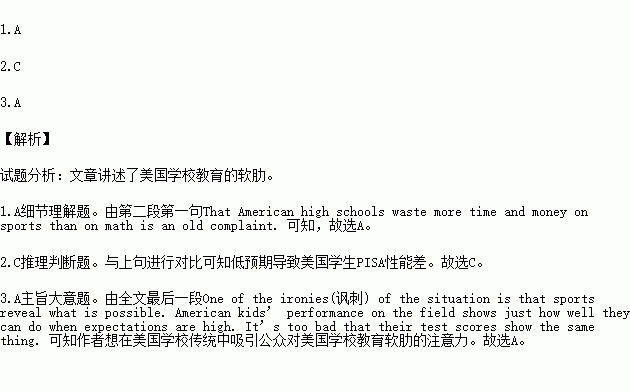题目内容
In her new book, “The Smartest Kids in the World,” Amanda Ripley, an investigative journalist, tells the story of Tom, a high-school student from Gettysburg, Pennsylvania, who decides to spend his senior year in Warsaw, Poland. Poland is a surprising educational success story: in the past decade, the country raised students’ test scores from significantly below average to well above it. Polish kids have now outscored(超过……分数) American kids in math and science, even though Poland spends, on average, less than half as much per student as the United States does. One of the most striking differences between the high school Tom attended in Gettysburg and the one he ends up at in Warsaw is that the latter has no football team, or, for that matter, teams of any kind.
That American high schools waste more time and money on sports than on math is an old complaint. This is not a matter of how any given student who plays sports does in school, but of the culture and its priorities. This December, when the latest Program for International Student Assessment(PISA) results are announced, it’s safe to predict that American high-school students will once again display their limited skills in math and reading, outscored not just by students in Poland but also by students in places like South Korea, Belgium, the Netherlands, Finland, Singapore, and Japan. Meanwhile, they will have played some very exciting football games, which will have been breathlessly written up in their hometown papers.
Why does this situation continue? Well, for one thing, kids like it. And for another, according to Ripley, parents seem to like the arrangement, too. She describes a tour she took of a school in Washington D.C., which costs thirty thousand dollars a year. The tour leader—a mother with three children in the school—was asked about the school’s flaws(暇疵). When she said that the math program was weak, none of the parents taking the tour reacted. When she said that the football program was weak, the parents suddenly became concerned. “Really?” one of them asked worriedly, “What do you mean?”
One of the ironies(讽刺) of the situation is that sports reveal what is possible. American kids’ performance on the field shows just how well they can do when expectations are high. It’s too bad that their test scores show the same thing.
1.According to Paragraph 2, we know that _______.
A. too much importance is placed on sports in America
B. little time is spent on sports in Japanese schools
C. American high schools complain about sports time
D. PISA plays a very important role in America
2.The underlined sentence in the last paragraph means _______.
A. American students’ academic performance worries their parents a lot
B. high expectations push up American students’ academic performance
C. low expectations result in American students’ poor PISA performance
D. lacking practice contributes to American students’ average performance
3.The purpose of this article is to _______.
A. draw public attention to a weakness in American school tradition
B. call on American schools to learn from the Polish model
C. compare Polish schools with those in America
D. explain what is wrong with American schools and provide solutions
 阅读快车系列答案
阅读快车系列答案
